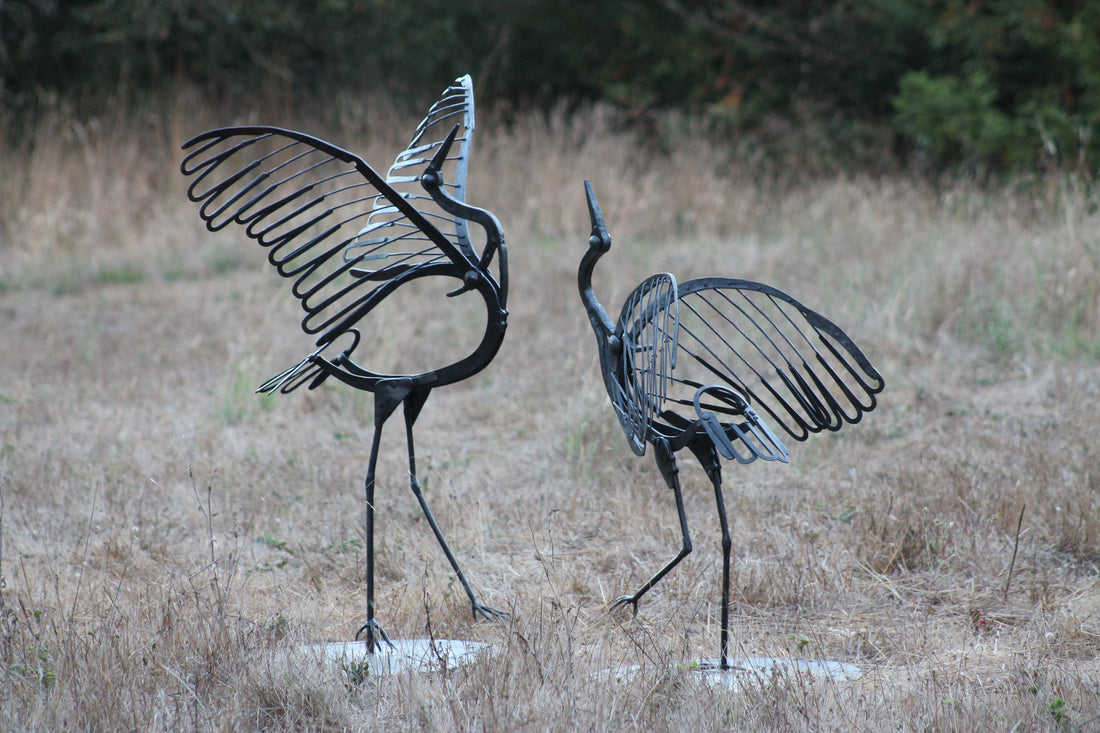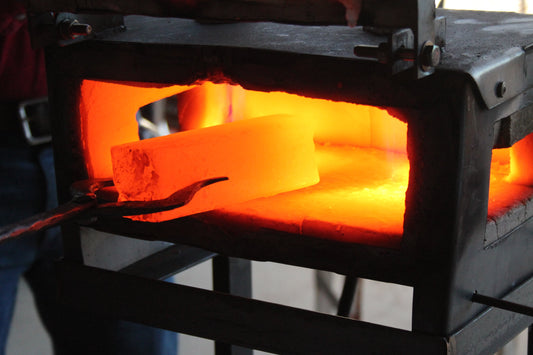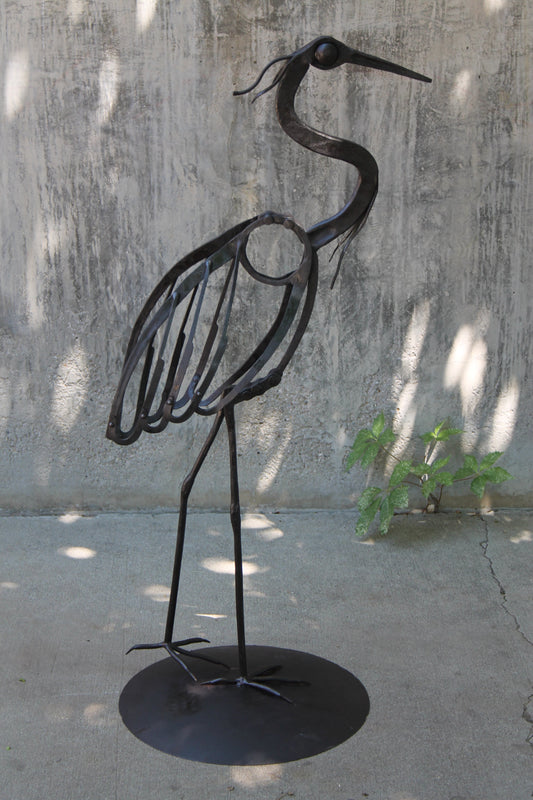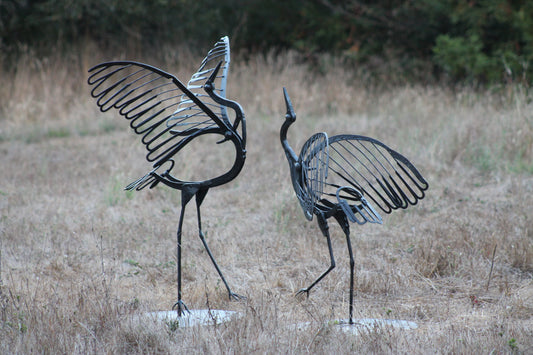Hephaestus was a blacksmith but he was also the King of the artisans. In the days of the Greeks, artists gave prayers and offerings to a god that was represented by the hammer and anvil. Throughout time the blacksmith was the origin of art and industry. From the stone carver to the seamstress, everyone required the services of a smith. Yet today when our society has more industry than ever, the blacksmith is not recognized as a maker of art.
Since time immemorial painters and stone carvers have been recognized for their fine art. The same can be said for the goldsmith and the silversmith. Bronze work has been esteemed for its art value almost as soon as the technology for casting bronze was developed. Pottery was elevated to a fine art a few centuries ago, which century depends on which hemisphere you are in. Still forging the black metal has remained utilitarian. Granted many beautiful things have been made from iron through out the ages but they have mostly remained as functional items. From the door hinges of Notre Dame to the prolific work of Samuel Yellin, it may be artistic work but it has remained mostly practical, useful items.
A few blacksmiths have made their mark as strickle artist, building gallery quality art with little to no utilitarian value. Albert Paley comes to mind. But for the most part blacksmiths have seen their works shunned by galleries and wealthy collectors. Being esteemed by art galleries and wealthy collectors is not the life goal of many blacksmiths. However, being recognized for their skill publicly and financially is a desire of many a smith. Financial compensation being a necessity of life for many of us. When it comes art, the galleries and wealthy collectors are often the gate keepers to that success. In our fickle society, popular and cool is defined for the masses by what someone else tells them it is. In the art world that means galleries and wealthy collectors. The accomplishments of Lyman Whitaker come to mind. His kinetic sculptures made it from the obscure galleries of Utah to cheap knock offs in every Costco because it was good art and the right people said it was cool. It became recognized by the masses. Most of us may not be looking for that level of “success” but I am sure we would all take the money.
If you are reading this, you most likely have some level of passion for blacksmithing, either as a practitioner of the craft or as someone that recognizes the skill and beauty of the art. Count yourself in a small majority, because most of the world has little idea how we do what we do with hot metal and brute force. The first time someone asked me how often I get kicked by horses when I told them I was a blacksmith I was terribly confused. With all do respect to those of you who shoe horses, how did Blacksmithing go from the king of the artisans to only being associated with the humble horse shoe and the railroad spike knife. With the rise of the industrial revolution and the mass production of steel, the demand for blacksmiths and their skills has steadily declined. The profession of blacksmithing has seen more change in the past 200 years than in the previous thousand years. Contrary to what common sense would say, the more steel we have in our lives, the more machines we have building things for industry, the less demand society has for the men and women that built the machines in the first place.
In today’s society metal seem to be the artistic flare found in every public space. The doctor’s office that has corten planter boxes and the local bistro with the rusty tin roofing stapled up around the bar. Welded yard art comes up from Mexico by the truck load and every asphalt ranchette is required to have a plasma cut name sign over the entrance. Repurposed rusty metal welded into “funky” art, draws a premium price at galleries. Meanwhile true blacksmith art is still languishing in the wings, misunderstood and undervalued. When I say blacksmith art, I am talking fully forged, riveted, upset and drawn-out pieces. I am not talking about rebar someone bent with a cutting torch. As a whole, artisan blacksmiths are not getting the same recognition in fine art galleries and by wealthy collectors that welded art and other metal art is getting. Did we miss something?
At the beginning of the 20th century many colleges had a blacksmithing shop. Most of these where focused on farming and where part of the Ag Department with in those colleges. Cornell University published a large quantity of instructional materials on the subject of forging. As the industrial revaluation took hold the blacksmiths that helped develop electrical and gas welding found themselves replaced by that very technology. Today many colleges and universities have welding and manufacturing as part of their curriculum, but only one college in the United States has blacksmithing as a post graduate degree.
While many European countries have a long history of blacksmithing as a fine Art, not just an industry, the United States’ blacksmithing history is largely based on industrial and utilitarian needs. As the industrial revaluation hit, we as a country did not have the depth of history to support a flourishing arts culture around blacksmithing. So much of the American blacksmithing tradition is focused on the “winning of the west.” Be it the California Gold Rush or the post-Civil War western expansion with the trans continental railroad. I hear the discussions “or arguments” of traditional blacksmithing and its importance in the westward movement of this country way more often than blacksmithing’s contributions to the Art History of American. Blacksmithing was a necessity in America, a society that has always been over shadowed by its ability to thrive and expand with limited resources. Art has always been an excess, which limits its ability to thrive in a society that is struggling to survive, like so many of the pioneers that moved west in this country.
Obviously we can blame the industrial revolution for putting us out of work. But, there was an attempt to hang on to the personal touch of the crafts in the early stages of the industrial revolution. The Arts and Crafts movement was as much a social movement as it was an art style. In an attempt to preserve the worthiness of an individual’s skill and knowledge, in a time of mass production, the Arts and Crafts movement focused on quality and uniqueness. Some forging work is still heavily influenced by the Arts and Crafts style, but as a whole blacksmithing was not elevated to a fine art during the height of the movement. This would have been a great occasion to elevate blacksmithing to the fine art level. Unfortunately the Arts and Crafts movement fizzled out as a result of World War One.
The great social change of the 1960’s and 70’s was another great opportunity for the craft to come into their own as an art form that was properly appreciated by the masses. Woodworking is a great example of this. The 70’s saw numerous publications like Fine Woodworking dedicated to the craft. Wood pieces started showing up more in galleries and art collections. A large portion of the population became familiar with the skills associated with the many facets of wood working, everything from spoon carving and lathe turning to furniture making. Who hasn’t seen an episode of The New Yankee Work Shop with the great Norm Abram. This was the same decade that saw the formation of the California Blacksmith Association (CBA) and the Artist-Blacksmith’s Association of North America (ABANA). Yet some how forged metal did not gain the same prestige as an art form that woodworking did. Did we miss something?
There are a lot of reasons woodworking excelled in popularity. Back in those days we still had wood shop in our high schools. The learning curve for many wood crafts is not as steep as forging. And the tools are much more available. My father has been a farmer my whole life, he gave me much of my knowledge base for working with metal. He is a talented fabricator well beyond the standard farm repair. Yet as a kid I remember him using his Christmas money from grandma to outfit a woodworking shop (thank you Sears and Robuck) to build furniture as a hobby. Woodworking is much more obtainable to the general public. I am not knocking the skill that goes into fine wood craft, but few people would have a wood shop in their garage if it took ten or twelve(or even more) tries to build every new project; like it does with blacksmithing. People buy what they know. A piece of fine art that is made from wood is known by a much higher percentage of the population than a similar piece that is forged from steel.
The blacksmiths themselves might be to blame for their lack of success as artists. I could fill many a page with the eccentricities of blacksmiths, but for this purpose I will generalize. Many of us are more focused on the necessities of life, trying to make money to feed our families. It is hard to spend time and money to build art that may or may not sell when you have bills to pay. Metalsmiths have always straddled the line between traditional and new technology. Yet in today’s world that gap has grown even wider. Making our craft relevant in a digital world is a challenge that many of us may not have the skills or desire to do. I know more than a few Luddites among us who are afraid of new technology. And not everyone wants to make Art. Many of our group are Craftsman and women with a capital “C”, focused on the how and why of blacksmithing. They are happy producing high-quality utilitarian products for the customers they already have with no need to push into a new area of sales.
As we start to make a few generalizations about the people in our profession it becomes obvious one of the problems is there just is not that many of us. It comes down to shear numbers. There is a very small percentage of smiths that are trying to earn their living or even a portion of their income as a smith and there is an even a smaller number that want to do that with art. Every time I go to a gallery and I see a bunch of rusty reclaimed metal weld art (have I mentioned I don’t like rusty weld art) I think why is there no forged metal art here. The answer is there just is not enough people making forged pieces of art for it to be available in more than a few a places. To show your art some place you need a body of work. That means a half dozen or a dozen sculptures that you can show to a gallery owner or museum curator to prove that you have the chops to be in their show. That’s a lot of time, energy and finical outlay, with no guarantee of return on the other side. And that is just the pieces themselves, I am not even talking about the tools you need, the years of experience to produce a piece that is high enough quality, the finishing, the crating, the hauling it to a show, the photo shoots, the advertising, the networking, the so on and so on and so on. Forged metal art has its challenges simply because of the nature of the medium that it is. Nothing we make is light, its three dimensional, its hard to photograph, it takes up lots of space in a gallery, the list of negatives in regards to forged steel art is greater when compared to a painting that can be hung on a wall. This struggle is amplified when you look at public art. Many of the pieces I would like to display would not work in a public space. They have sharp pointy pieces that can hurt people or be broken off. Forged steel requires a lot of work to finish and treat so it doesn’t rust away. A nice welded painted metal sculpture for a public space if much easier to make and much more desirable for the client. That’s why we see rusty weld art everywhere rather then forged metal. Picaso was making welded direct metal sculptures in the 1920’s. It is not hard to get into. A harbor freight welder, a trip to the scrap yard, a couple YouTube videos and your off and running. Blacksmithing takes time to learn, time to develop your technique, time to build enough equipment to do what you have envisioned. I am sure there are a lot of smiths who would like to see their art in a gallery and who deserve to have their art seen by the world. But there is only so many people that have the drive to put aside all of life’s other demands and distractions to make it happen.
ABANA and CBA and the many other organizations across the country have done great things for the blacksmithing community over the last 5 decades. Educating many a new smith, bringing people together as a community and sharing ideas. We have a good solid foundation built by the women and men that went before us. Some have left their mark and are no longer with us, many are still here willing to continue lifting us up. Despite all the struggles blacksmithing is and has faced (the death of the village blacksmith thanks to the industrial revaluation, the fact our society does not associated forging with fine art, lack of representation in galleries) there are more artisan blacksmiths in the U.S. today then ever before. The ground work done by the generations before us, by creating CBA and ABANA, by educating so many new smiths. More and more smiths are able to express themselves through forged iron. Earning a living making non utilitarian items with hammer and anvil. Society is recognizing the beauty and craftsmanship that went into grandma’s scrolled gate and they want to bring that into their home in new ways that they relate to. There is a demand for handmade items and forged items in our society and that demand will continue to grow as we expose more people to what is possible with hot steel and brute force. To show the world we make more that horseshoes.



